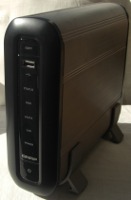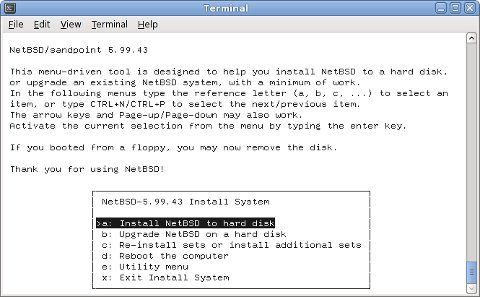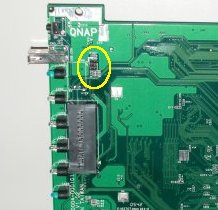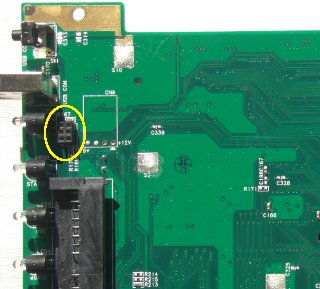QNAP Turbo Station Installation
|
This document describes in depth how to prepare your QNAP Turbo Station for installing NetBSD/sandpoint. The following models are supported:
To install NetBSD/sandpoint you will have to open the case, to get access to the serial console, and connect a serial converter from TTL to RS232 signal levels. |

|
There is a 6-pin header near the LEDs, labeled JP2.
On the V1.02 board it is a male connector with pins (left picture),
while it is a female socket on V200 boards (right picture).
Nevertheless, the signal assignments on both connectors are the same.
Serial header pin assignments (both boards):
The Turbo Station's serial port is using 3.3V TTL levels, which have to be converted into regular RS232 levels by a level shifter circuit. If you are not anxious using a soldering iron you find detailed instructions how to build such a converter here:
Another option is to buy such a converter. There are solutions for a standard RS232 interface and for an USB interface. Look out for:
- RS232 level shifter / breakout board (MAX3232 based)
- USB to TLL serial level shifter / breakout board (FT232 based)
Provided the serial converter is installed and working correctly you should be able to connect to the firmware's serial console. QNAP is using U-Boot, the Universal Boot Loader.
Now you can connect with any terminal program to the Turbo Station's
serial console. The easiest approach may be to use NetBSD's
tip(1) command to make a direct console
connection at 115200bps.
# tip -115200 console
Note that when using a serial connection via USB you may have to
make an entry for /dev/ttyU0 in
/etc/remote.
Immediately after switching your Turbo Station on it will display the following information (output is from a TS-101) and gives you two seconds to stop autobooting.
U-Boot 1.1.2 (Aug 28 2005 - 13:37:25) QNAP System, Inc. CPU: MPC8245 Revision 1.4 at 266.666 MHz: 16 kB I-Cache 16 kB D-Cache Board: Sandpoint 8245 Unity ##Test not implemented yet## I2C: ready DRAM: 64 MB FLASH: S29GL128N, 16 MB In: serial Out: serial Err: serial Net: No ethernet found. Hit any key to stop autoboot: 1
The altboot(8) utility functions as a bridge between
the QNAP firmware and the NetBSD kernel startup environment.
NAS firmware often provides no means to boot a kernel from disk or
from the network and doesn't initialize all hardware correctly.
We will also use it to pass a bootinfo list to the kernel.
The altboot boot loader has to be loaded and started
using U-Boot. Usually there are three ways to invoke it:
- loadb to load a binary file via serial line in kermit mode
- tftpboot to load a binary file over the network with TFTP protocol
- start it from the flash memory
The last option is prefered once the installation is completed, but
obviously it is not possible for the first time boot. As QNAP's
U-Boot also lacks network functionalities in this version, we will
download altboot into RAM with Kermit protocol
over the serial line.
Install kermit(1) from pkgsrc(7)
or compile and install it yourself. To set up the file transfer you
have to provide the following commands to kermit:
set line /dev/tty00 set speed 115200 set carrier-watch off set flow-control none robust set file type bin
For convenience you can write them into a file which you can pass as an argument to kermit.
Load altboot into memory with Kermit protocol.
The binary is relocated at 0x1000000, so type:
=> loadb 1000000
## Ready for binary (kermit) download to 0x01000000 at 115200 bps...
Now quit your terminal program and launch
kermit cmdfile. When you are already running
kermit enter the command mode by typing
CTRL-\ followed by C.
Then send altboot.bin. Reconnect when the
transfer is finished.
C-Kermit 8.0.211, 10 Apr 2004, for NetBSD 1.6
Copyright (C) 1985, 2004,
Trustees of Columbia University in the City of New York.
Type ? or HELP for help.
(/tmp/) C-Kermit>send path_to/altboot.bin
Now you can use altboot to launch the
netbsd-INSTALL kernel for installing NetBSD.
You may choose to load it via TFTP or from NFS. For TFTP you have
to enable tftpd(8) in
/etc/inetd.conf, and for NFS there is a
documentation at
The Network File System. But in both cases you
have to set up a DHCP server, which is explained in the
DHCP Howto
. An appropriate dhcpd.conf entry could
look like this:
host turbostation {
hardware ethernet 00:e0:4c:xx:xx:xx;
fixed-address 192.168.0.104;
next-server 192.168.0.1;
option root-path "/export/turbostation/root";
}
The root-path option is only needed when using NFS and
should match your exported NFS directory.
Uncompress netbsd-INSTALL.gz from the
NetBSD/sandpoint distribution and copy it into the NFS or TFTP
directory.
Then start the DHCP, NFS or TFTP server and boot the installation kernel
from the firmware either with
=> go 1000000 tftp:netbsd-INSTALL
or from NFS:
=> go 1000000 nfs:netbsd-INSTALL
At the time of writing the network transfer will fail for the first time after cold start. After an automatic reset, caused by five xmit failures, it should succeed. This will hopefully improve in future.
Our bootloader configures the hardware, determines the IP address, loads the kernel via network and launches it:
## Starting application at 0x01000000 ...
>> NetBSD/sandpoint altboot, revision 1.7 (Sat May 28 12:36:26 CEST 2011)
>> QNAP TS, cpu 265 MHz, bus 132 MHz, 64MB SDRAM
wd0: <SAMSUNG HD502HI> DMA LBA LBA48 476940 MB
wd0: no disklabel
MAC address 00:e0:4c:xx:xx:xx
100Mbps-FDX
Hit any key to enter interactive mode: 0
loading "netbsd-INSTALL" 5143540+110580=0x503068
entry=0x90000, ssym=0x592be8, esym=0x593068
Copyright (c) 1996, 1997, 1998, 1999, 2000, 2001, 2002, 2003, 2004, 2005,
2006, 2007, 2008, 2009, 2010, 2011
The NetBSD Foundation, Inc. All rights reserved.
Copyright (c) 1982, 1986, 1989, 1991, 1993
The Regents of the University of California. All rights reserved.
NetBSD 5.99.52 (INSTALL) #6: Sat May 28 12:44:03 CEST 2011
frank@compaq.owl.de:/home/frank/netbsd/current/src/sys/arch/sandpoint/compile/obj/INSTALL
total memory = 65536 KB
avail memory = 57980 KB
OpenPIC Version 1.2: Supports 1 CPUs and 26 interrupt sources.
mainbus0 (root)
cpu0 at mainbus0: 8245 (Revision 0.4), ID 0 (primary)
cpu0: HID0 0x90c000<DOZE,DPM,ICE,DCE>, powersave: 1
eumb0 at mainbus0
com0 at eumb0 unit 0: ns16550a, working fifo
com0: console
com0: interrupting at irq 40
ociic0 at eumb0
iic0 at ociic0: I2C bus
s390rtc0 at iic0 addr 0x30: Seiko Instruments 35390A Real-time Clock
satmgr0 at eumb0 unit 1: button manager (qnap)
satmgr0: interrupting at irq 41
pci0 at mainbus0 bus 0
pchb0 at pci0 dev 0 function 0
pchb0: vendor 0x1057 product 0x0006 (rev. 0x14)
satalink0 at pci0 dev 13 function 0: Silicon Image SATALink 3512 (rev. 0x01)
satalink0: using irq 16 for native-PCI interrupt
atabus0 at satalink0 channel 0
atabus1 at satalink0 channel 1
ohci0 at pci0 dev 14 function 0: vendor 0x1033 product 0x0035 (rev. 0x43)
ohci0: interrupting at irq 17
ohci0: OHCI version 1.0
usb0 at ohci0: USB revision 1.0
ohci1 at pci0 dev 14 function 1: vendor 0x1033 product 0x0035 (rev. 0x43)
ohci1: interrupting at irq 17
ohci1: OHCI version 1.0
usb1 at ohci1: USB revision 1.0
ehci0 at pci0 dev 14 function 2: vendor 0x1033 product 0x00e0 (rev. 0x04)
ehci0: interrupting at irq 17
ehci0: companion controllers, 3 ports each: ohci0 ohci1
usb2 at ehci0: USB revision 2.0
re0 at pci0 dev 15 function 0: RealTek 8169SC/8110SC Single-chip Gigabit Ethernet (rev. 0x10)
re0: interrupting at irq 18
re0: Ethernet address 00:e0:4c:xx:xx:xx
rgephy0 at re0 phy 7: RTL8169S/8110S/8211 1000BASE-T media interface, rev. 2
rgephy0: 10baseT, 10baseT-FDX, 100baseTX, 100baseTX-FDX, 1000baseT, 1000baseT-FDX, auto
biomask 8000038 netmask 8000038 ttymask 8000038
satalink0: port 0: device present, speed: 1.5Gb/s
wd0 at atabus0 drive 0
wd0: <SAMSUNG HD502HI>
wd0: 465 GB, 969021 cyl, 16 head, 63 sec, 512 bytes/sect x 976773168 sectors
uhub0 at usb0: vendor 0x1033 OHCI root hub, class 9/0, rev 1.00/1.00, addr 1
uhub1 at usb1: vendor 0x1033 OHCI root hub, class 9/0, rev 1.00/1.00, addr 1
uhub2 at usb2: vendor 0x1033 EHCI root hub, class 9/0, rev 2.00/1.00, addr 1
boot device: re0
root on md0a dumps on md0b
root file system type: ffs
erase ^H, werase ^W, kill ^U, intr ^C, status ^T
Terminal type? [vt100]
Just follow the usual procedure to install a NetBSD system.

After a successful installation you want to make the system boot
standalone when switched on, without the need for a serial console.
So you have to modify the bootcmd in U-Boot's environment
and write the altboot.bin binary to the Flash ROM.
To find a suitable place in the Flash ROM you can use the
flinfo command and look out for empty sectors
(E). On my Turbo Station I have chosen
0xffe20000. Replace that in all the following
commands if you have chosen a different address.
Load altboot.bin into memory at
0x1000000 again, as explained above.
Then execute the following commands to write it to Flash ROM:
=> protect off ffe20000 ffe3ffff Un-Protected 1 sectors => erase ffe20000 ffe3ffff . done Erased 1 sectors => cp.b 1000000 ffe20000 18000 Copy to Flash... done => protect on ffe20000 ffe3ffff Protected 1 sectors
Finally adapt the bootcmd environment string to
autoboot altboot and start the
netbsd kernel (which is the default name) from
wd0 on each reboot:
=> setenv bootcmd cp.b ffe20000 1000000 18000\; go 1000000 wd0: => saveenv Saving Environment to Flash... Un-Protected 1 sectors Erasing Flash... . done Erased 1 sectors Writing to Flash... done Protected 1 sectors
The \ is important for setenv not to
misinterpret the ; as the end of the command.
Have fun with your mini NetBSD server!
Back to NetBSD/sandpoint Port Page



